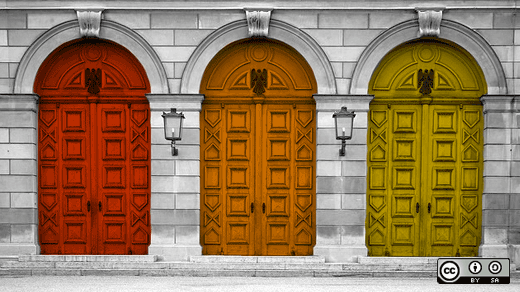Exploring different desktops is a good thing. I’ve recently converted to GNOME 3 ("hallowed be its Name in all the earth, etc.") and I admit freely to enjoying it (a lot).
I also have to admit that part of the reason I’m enjoying it is because it’s a change.
Change is good. It forces you out of your comfort zones, and makes you find new things, very useful things.
For example, look at Terminator vs. gnome-terminal.
I started up Terminator this morning, and noticed that it wanted me to use tabs instead of separate windows. Once I’d started some different tabs, it struck me that using the mouse to switch between them was rather inefficient, so I started looking for a key combination to switch.
And I found one, cleverly hidden in plain sight in the documentation: Ctrl+Page Up, and Ctrl+Page Down to move back and forth, much like screen uses Ctrl-A and Ctrl-P to move between panes.
Terminator is based on gnome-terminal, so it stands to reason (and also proves to be true through investigation) that gnome-terminal works the exact same way.
… based on “Much of the behaviour of Terminator is based on GNOME Terminal…” from Terminator’s home page. I’m very perceptive.
Now, have I switched from gnome-terminal to Terminator as a preferred shell, permanently?
I don’t know, honestly. I’m still playing around. Terminator is supposed to have some advantages for system administrators, and the ability to lay out shells sounds very nice, but I haven’t had enough experience with the app to say whether it feels good enough to be my default.
But there’s the whole concept of change being a learning agent. I learned something about gnome-terminal that was very good, and very useful, simply by deciding to wander off into the unknown.
“Oh, look,” I said to myself, “This is a neat feature, I wonder if gnome-terminal has a similar feature. It does! It does have a similar feature!”… and the world grows a tiny bit.
Moving to GNOME 3 was like this. I hated it at first, couldn’t understand why GNOME would do this to me (and why Fedora would allow GNOME to do this to me).
I installed Cinnamon to help, only to find that Cinnamon at the time was insufficient.
I went back to WindowMaker, only to find that I’d moved on from NextStep somewhere along the line.
Then it hit me: “Wait, why did they bother?” There had to be a reason; even GNOME couldn’t be so stupid as to totally cripple its users for no obvious reason.
I don’t think I need to explain that GNOME 3's adoption has been… rocky. The GNOME 3 developers have been just a touch arrogant in the whole process, and they’ve done a terrible, terrible job of helping the users understand their position. As a result, users haven’t understood at all, and have fled in amazing numbers. Way to go, GNOME 3! Who’s running you, Maurice Podoloff? Darl McBride?
So then I took a deep breath, and read up a little on GNOME 3, and learned just a touch about how to use it. I learned about the action key (which, oddly enough, bears the Windows logo.) I looked at the actual desktop capabilities.
I pretended that its lack of screensavers wasn’t a liability. (People like screensavers! I like screensavers! Screensavers are the real reason I tried MATE! … wait, did I type that out loud?)
The result was that all of a sudden GNOME 3 turned into a powerhouse. I flew from application to application, virtual desktop to virtual desktop. I felt free, even if sometimes I wished it were able to do some really simple things.
I wished it could so some simple things… like, you know, screensavers.
Of course, change works the other way, too. I may have mentioned that I tried MATE as a replacement for GNOME 3; MATE is a repackaging of GNOME 2.
It was neat. It felt archaic after using GNOME 3, and some things just didn’t feel right. But it gave me some ideas about how to use GNOME 3 differently (including Terminator and yumex) which have proven to be actually pretty useful.
MATE supports screensavers, incidentally.
Change is good; the wonder of computing is that you can try new things (Linux instead of Windows! MATE instead of GNOME 3!) without usually destroying the ability to go back to what you had before… and the ability to shift your mindset somewhat is very useful.
Originally posted on enigmastation.com and re-posted with permission.







29 Comments